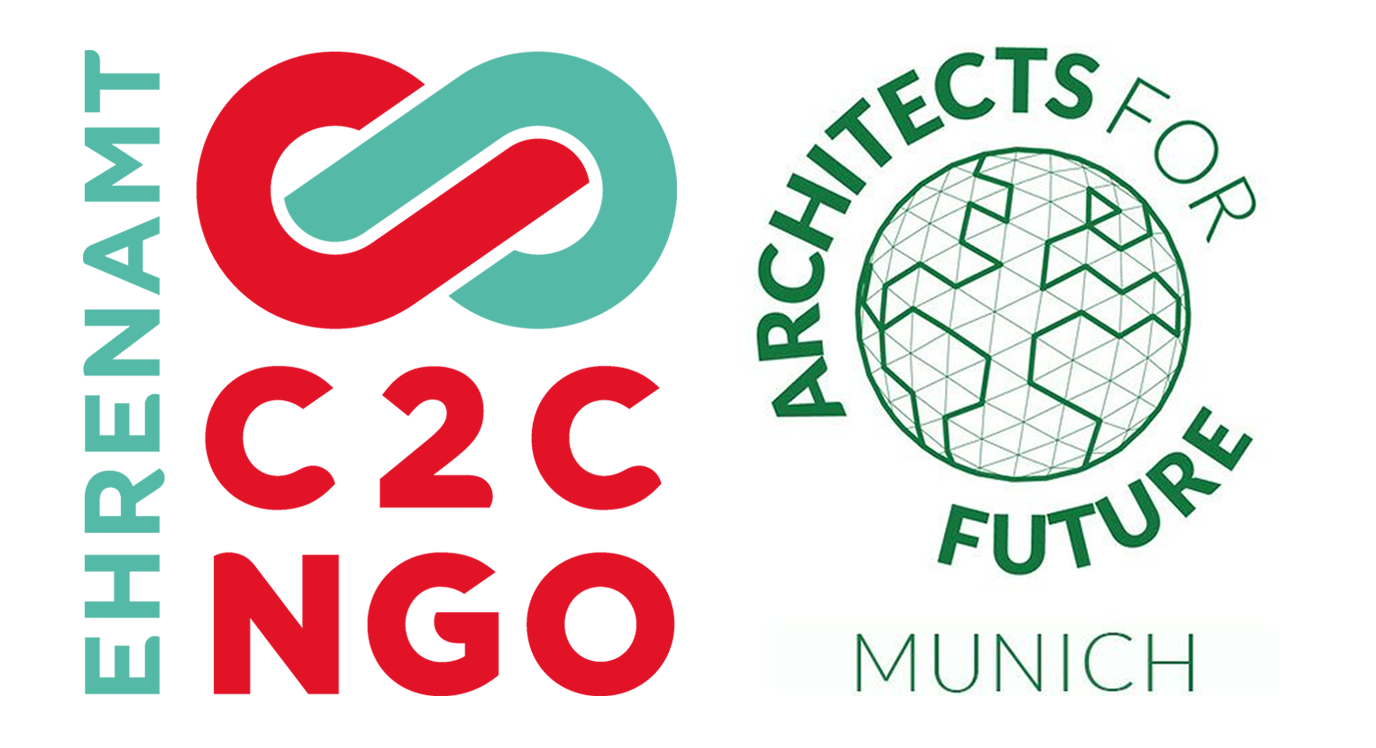Nachstehend sind weiterführende Links zu aktuellen Forschungsprojekten sowie Literatur zu den Themen Cradle to Cradle sowie klimafreundliches und kreislaufgerechtes Planen und Bauen aufgeführt. Die Liste erhebt keinen Anspruch auf Vollständigkeit, sondern stellt vielmehr eine Auswahl dar, die zum Weiterlesen motivieren soll.
Gebaute Beispiele
- Rathaus in Venlo, NL
https://www.c2cexpolab.eu/de/referenzen/stadthaus-venlo/http://www.c2c-centre.com/sites/default/files/infographic-def-DU-def2.pdf - Park 20|20 in Hoofddorp-Beukenhorst-Zuid (bei Amsterdam, NL)
http://www.park2020.com/ - Triodos Bank in Driebergen-Zeist, NL
https://www10.aeccafe.com/blogs/arch-showcase/2019/09/22/triodos-bank-in-driebergen-zeist-the-netherlands-by-rau-architects/
https://www.archdaily.com/926357/triodos-bank-rau-architects/5da087753312fd498d000045-triodos-bank-rau-architects-circularity-diagram - Urban Mining and Recycling (UMAR), NEST in Dübendorf (bei Zürich, CH)
http://nest-umar.net/ - C2C-Gewerbegebiet in Bielefeld:
https://www.wege-bielefeld.de/fileadmin/user_upload/download/C2C-BIZZ_Broschuere_Zusammenfassung_Projektergebnisse_Bielefeld.pdf - Energieeffizienzhausplus in Berlin:
https://www.bmi.bund.de/DE/themen/bauen-wohnen/bauen/energieeffizientes-bauen-sanieren/effizienzhaus-plus/effizienzhaus-plus-node.html
Weitere Links
- https://muenchen-muss-handeln.de/
- Was ist Cradle to Cradle (deutsch): https://www.youtube.com/watch?v=g1tIGLy3PHw
- Prof. Dr. Michael Braungart:
– Cradle to Cradle Workshop – Entrepreneurship Summit 2016: https://www.youtube.com/watch?v=yfNinEucsbE
– Plastik: Ein C2C Material? – Cradle to Cradle Congress 2018: https://www.youtube.com/watch?v=Knqi1X8J0Wk - https://www.bamb2020.eu/
- https://architecture2030.org
Literatur
- Adams, K. T., Osmani, M., Thorpe, T., & Thornback, J. (2017). Circular economy in construction: Current awareness, challenges and enablers. Proceedings of the Institution of Civil Engineers – Waste and Resource Management, 170(1), 15–24. https://doi.org/10.1680/jwarm.16.00011.
- Braungart, M., McDonough, W. (2006). Cradle to Cradle design: creating healthy emissions – a strategy for eco-effective product and system design. Journal of Cleaner Production, jrg. 2006. pp. 1-12.
- Braungart, M., McDonough, W. (1992). The Hannover Principles, Design for Sustainability. Charlottesville, McDonough & Partners. http://dx.doi.org/10.4135/9781412974608.n85.
- Circle Economy. (2020). The circularity gap report. https://www.circularity-gap.world/2020.
- Durmiševic´, E. (2018). Reversible building design. In: M. Charter, Designing for the Circular Economy (1. Aufl., S. 344–359). Routledge. https://doi.org/10.4324/9781315113067-32.
- Debacker, Manshoven (2016). BAMB. Key barriers and opportunities for Materials Passports and Reversible Building Design in the current system. Horizon2020, Europäische Union. https://www.bamb2020.eu/wp-content/uploads/2016/03/D1_Synthesis-report-on-State-of-the-art_20161129_FINAL.pdf.
- Ellen MacArthur Foundation, Completing the Picture: How the Circular Economy Tackles Climate Change (2019) https://www.ellenmacarthurfoundation.org/publications/completing-the-picture-climate-change.
- Europäische Kommission (2014). Mitteilung der Kommission an das Europäische Parlament, den Rat, den Europäischen Wirtschafts- und Sozialausschuss und den Ausschuss der Regionen zum effizienten Ressourceneinsatz im Gebäudesektor. https://ec.europa.eu/transparency/regdoc/rep/1/2014/DE/1-2014-445-DE-F1-1.Pdf.
- Europäische Kommission (2019). BAMB. Buildings as Material Banks: Integrating Materials Passports with Reversible Building Design to Optimise Circular Industrial Value Chainshttps://cordis.europa.eu/project/id/642384/results.
- Fischer, A. et. al., (2019). Building Value. A pathway to circular construction value. Circle Economy, Sustainable Finance Lab, Nederland Circulair! https://www.circle-economy.com/insights/building-value.
- Geldermans, R. J. (2016). Design for Change and Circularity – Accommodating Circular Material & Product Flows in Construction. Energy Procedia, 96, 301–311. https://doi.org/10.1016/j.egypro.2016.09.153.
- Hansen, K., Mulhall, D., Zils, M. et. al. (2014). Luxembourg as a knowledge capital and testing ground for the Circular Economy. National Roadmap for Positive Impacts. Tradition, Transition, Transformation. Ministry of the Economy Grand Duchy of Luxembourg. https://www.luxinnovation.lu/wp-content/uploads/2017/05/Luxembourg-Circular-Economy-Study.pdf.
- Thelen, D., Acoleyen M., Huurman, W., Thomaes, T., Brunschot, C., Edgerton, B., Kubbinga, B., (2018). Scaling the circular Built Environment – pathways for business and government. https://docs.wbcsd.org/2018/12/Scaling_the_Circular_Built_Environment-pathways_for_business_and_government.pdf.
- Heinrich, M., Lang, W. (2019). Erfassung und Steuerung von Stoffströmen im urbanen Wohnungsbau – Am Beispiel der Wohnungswirtschaft in München-Freiham.
https://www.researchgate.net/publication/332878297_Erfassung_und_Steuerung_von_Stoffstromen_im_urbanen_Wohnungsbau_-_Am_Beispiel_der_Wohnungswirtschaft_in_Munchen-Freiham_Capture_and_Control_of_Material_Flows_and_Stocks_in_Urban_Housing_Based_on_the_C. - Heinrich, M., Lang, W. (2019). Materials Passports – Best Practice – Innovative Solutions for a Transition to a Circular Economy in the Built Environment. https://www.bamb2020.eu/wp-content/uploads/2019/02/BAMB_MaterialsPassports_BestPractice.pdf.
- Hillebrandt, A., Seggewies, J-K. (2018). Atlas Recycling. Recyclingpotenziale von Baustoffen: Gebäude als Materialressource. 10.11129/9783955534165-010. https://www.degruyter.com/viewbooktoc/product/503637.
- ISO 20887 (2020). Sustainability in buildings and civil engineering works — Design for disassembly and adaptability — Principles, requirements and guidance. https://www.iso.org/standard/69370.html.
- McDonough, W., Braungart, M. (2002). Cradle to Cradle: Remaking the Way We Make Things. New York: North Point Press. ISBN 0865475873. OCLC 47623923.
- Mulhall, D., Braungart, M. (2010). Cradle To Cradle criteria for the built environment. EKONOMIAZ. Revista vasca de Economía, Gobierno Vasco / Eusko Jaurlaritza / Basque Government, vol. 75(04), pages 182-193. https://www.c2cplatform.tw/upload/file/Cradle%20to%20Cradle%20Criteria%20for%20the%20built%20environmen.pdf.
- Mulhall, D., Braungart, M., & Hansen, K. (2019). Creating Buildings With Positive Impacts. Technische Universität München, in association with BAMB. https://www.bamb2020.eu/wp-content/uploads/2019/02/Creating-Buildings-with-Positive-Impacts.pdf.
- Lucon O., D. Ürge-Vorsatz, A. Zain Ahmed, H. Akbari, P. Bertoldi, L. F. Cabeza, N. Eyre, A. Gadgil, L. D. D. Harvey, Y. Jiang, E. Liphoto, S. Mirasgedis, S. Murakami, J. Parikh, C. Pyke, and M.V. Vilariño, 2014: Buildings. In: Climate Change 2014: Mitigation of Climate Change. Contribution of Working Group III to the Fifth Assessment Report of the Intergovernmental Panel on Climate Change [Edenhofer, O., R. Pichs-Madruga, Y. Sokona, E. Farahani, S. Kadner, K. Seyboth, A. Adler, I. Baum, S. Brunner, P. Eickemeier, B. Kriemann, J. Savolainen, S. Schlömer, C. von Stechow, T. Zwickel and J.C. Minx (eds.)]. Cambridge University Press, Cambridge, United Kingdom and New York, NY, USA. https://www.ipcc.ch/site/assets/uploads/2018/02/ipcc_wg3_ar5_chapter9.pdf.
- Luscuere, Lars. (2016). Materials Passports: Optimising value recovery from materials. Proceedings of the Institution of Civil Engineers – Waste and Resource Management. 170. 1-4. 10.1680/jwarm.16.00016. https://www.researchgate.net/publication/312311382_Materials_Passports_Optimising_value_recovery_from_materials.
- v. d. Berg, M. C., Durmisevic, E. (2017). BIM uses for reversible building design. In E. Durmisevic (Ed.), Vital cities and reversible buildings: conference proceedings Mostar: Sarajevo Green Design Foundation. http://greendesignconference.com/gdc2017/wp-content/uploads/2017/11/Conference-Proceedings-3rd-Green-Design-Conference-web.pdf.
- v. d. Westerlo, B. (2011). Sustainable development and the Cradle to Cradle® approach in the built environment. University of Twente, Enschede. https://doi.org/10.3990/1.9789036531818.
